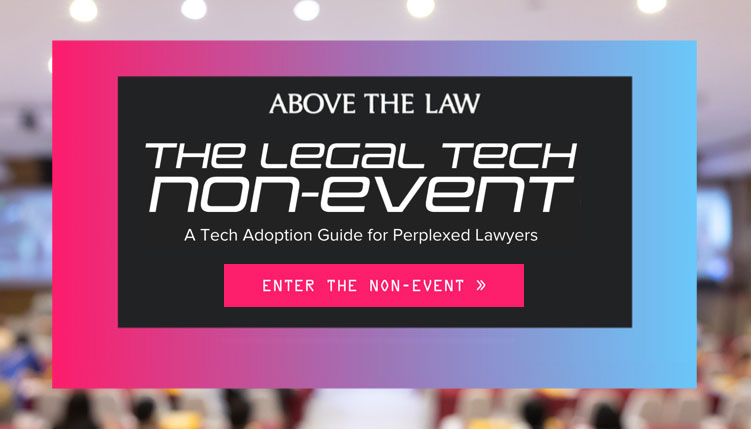
The Complex Buying Process (Part I)
//
 Back in February, Richard Tromans published a great article about why selling legal tech is so hard.
Back in February, Richard Tromans published a great article about why selling legal tech is so hard.
According to Richard, there are several reasons, including the challenge of the billable hour in law firms. Tech that makes attorneys more productive doesn’t translate into more billings — and in fact, it may be just as likely to do the opposite. Richard goes on to share a few other issues including the question, “Who are you actually selling to?”
googletag.cmd.push( function() { // Enable lazy loading. googletag.pubads().enableLazyLoad({ renderMarginPercent: 150, mobileScaling: 2 }); // Display ad. googletag.display( "div-id-for-top-300x250" ); googletag.enableServices(); });The reality is that whether it is a law firm or a law department that is looking to buy a solution, the purchase process is just as complex from the inside as it is from the outside as a sales representative selling legal tech.
 Sponsored A Summer Associate’s Guide To Thriving In The Biglaw Spotlight Congrats On Being A Summer Associate! Now Don’t F**k It Up. From Kinney Recruiting
Sponsored A Summer Associate’s Guide To Thriving In The Biglaw Spotlight Congrats On Being A Summer Associate! Now Don’t F**k It Up. From Kinney Recruiting Legal tech is challenging because multiple stakeholders are involved: procurement, IT, an evaluation committee, leadership, end users — and still others who have a stake in the outcome, including those who feel they may be affected adversely by the change introduced by a successful solution. It is challenging for buyers and sellers, but let’s look at this from the buyer’s perspective.
The Keys To Success
googletag.cmd.push( function() { // Enable lazy loading. googletag.pubads().enableLazyLoad({ renderMarginPercent: 150, mobileScaling: 2 }); // Display ad. googletag.display( "div-id-for-middle-300x250" ); googletag.enableServices(); }); googletag.cmd.push( function() { // Enable lazy loading. googletag.pubads().enableLazyLoad({ renderMarginPercent: 150, mobileScaling: 2 }); // Display ad. googletag.display( "div-id-for-storycontent-440x100" ); googletag.enableServices(); }); googletag.cmd.push( function() { // Enable lazy loading. googletag.pubads().enableLazyLoad({ renderMarginPercent: 150, mobileScaling: 2 }); // Display ad. googletag.display( "div-id-for-in-story-youtube-1x1" ); googletag.enableServices(); });There are three keys to success in the complex buying cycle: Stakeholder Alignment, Executive Leadership Support, and Change Management. In this installment, we’ll work through Stakeholder Alignment and Executive Leadership Support.
Stakeholder Alignment
Sponsored Sponsored A Summer Associate’s Guide To Thriving In The Biglaw Spotlight Congrats On Being A Summer Associate! Now Don’t F**k It Up. From Kinney Recruiting
Sponsored A Summer Associate’s Guide To Thriving In The Biglaw Spotlight Congrats On Being A Summer Associate! Now Don’t F**k It Up. From Kinney Recruiting  Sponsored Know The Laws And Risks To Fortify Security With Seton Hall Law's Data Privacy And Security Compliance Certificate Program Gibbons Institute of Law, Science & Technology, and Institute for Privacy Protection – Seton Hall From Seton Hall University School of Law
Sponsored Know The Laws And Risks To Fortify Security With Seton Hall Law's Data Privacy And Security Compliance Certificate Program Gibbons Institute of Law, Science & Technology, and Institute for Privacy Protection – Seton Hall From Seton Hall University School of Law  Sponsored Upcoming CLE Deadline? Make PLI.edu Your One Stop For All Things Compliance PLI makes compliance easy so you can get back to your practice. Log in to seamlessly track your progress and stream the CLE credits you… From PLI
Sponsored Upcoming CLE Deadline? Make PLI.edu Your One Stop For All Things Compliance PLI makes compliance easy so you can get back to your practice. Log in to seamlessly track your progress and stream the CLE credits you… From PLI  Sponsored Know The Laws And Risks To Fortify Security With Seton Hall Law's Data Privacy And Security Compliance Certificate Program Gibbons Institute of Law, Science & Technology, and Institute for Privacy Protection – Seton Hall From Seton Hall University School of Law
Sponsored Know The Laws And Risks To Fortify Security With Seton Hall Law's Data Privacy And Security Compliance Certificate Program Gibbons Institute of Law, Science & Technology, and Institute for Privacy Protection – Seton Hall From Seton Hall University School of Law When working toward the Stakeholder Alignment, it is important to first map out all of the stakeholders that are affected buy a potential new solution. Who might embrace the new solution? Who might resist it? What might motivate their behavior, and how might each stakeholder be persuaded?
This is a quick rubric that can help root out issues with each stakeholder and also help align your organization to support a new solution and the resulting beneficial changes. For each stakeholder, it is important to evaluate their needs from a tactical, strategic, political, and personal perspective.
Tactical issues. How does the proposed solution impact the day-to-day of a stakeholder across a year? Does the solution help them achieve the goals they have for the year? Does it make them harder? Does it fundamentally change them? Understanding the impact of a solution from a tactical perspective is important. If you can help someone understand how a proposed solution could help them achieve one of their performance goals, that is a great win.
googletag.cmd.push( function() { // Enable lazy loading. googletag.pubads().enableLazyLoad({ renderMarginPercent: 150, mobileScaling: 2 }); // Display ad. googletag.display( "div-id-for-bottom-300x250" ); googletag.enableServices(); });Strategic issues. How does the proposed solution impact the future of a stakeholder? Does it help them solve a longstanding problem or help them achieve long-term goals? For example, if a department head knows she cannot hire additional staff in the coming years, does your solution help her keep her department running efficiently so she can keep delivering quality work?
Often, a strategic issue at one level in an organization is a tactical issue further up the management chain. More on that later.
Sponsored Sponsored Why IP Assets Can Be An Attractive Investment Opportunity Yieldstreet is offering access to a well-known industry player. Here's how you can target long-term appreciation in patent portfolios. From Yieldstreet
Sponsored Why IP Assets Can Be An Attractive Investment Opportunity Yieldstreet is offering access to a well-known industry player. Here's how you can target long-term appreciation in patent portfolios. From Yieldstreet  Sponsored How Visionary GCs Can Find The Ideal Risk-Revenue Balance Can your legal team be an active driver of your organization’s revenue lifecycle management? Read on to find out. From Above The Law and Conga
Sponsored How Visionary GCs Can Find The Ideal Risk-Revenue Balance Can your legal team be an active driver of your organization’s revenue lifecycle management? Read on to find out. From Above The Law and Conga Political issues. As you work with stakeholders in the organization, the political aspects of this process can kick in, especially at more senior levels. Politics aren’t necessarily bad, but they are a reality in most organizations and should be taken into consideration during this process. Will this solution help advance someone’s career? Is their downside risk if this implementation fails? These are very important questions, especially for someone who will have a significant role as the economic buyer or an implementer.
Personal issues. Stakeholders are people with emotions, feelings, and lives outside of work. If a new solution is going to make work harder for them, or cause them to miss their kids’ soccer games, that will often bleed into the opinion of a stakeholder about a solution. End users are not typically the economic buyer or final decision maker for a product, but an easy-to-use interface that saves them time will often score a lot of points at the grass roots level for a new solution. Something easy to use that makes their life easier (including access to a system at home) can be great for gaining buy-in.
Executive Leadership Support
Leadership support can be tricky. Frankly speaking, projects that are driven from the top down are more likely to be successful. For those that don’t have leadership support, finding a way to align with leadership objectives will go a long way. But how do you do that? If you map out all stakeholders and work through the Stakeholder Alignment rubric above, it helps to provide greater visibility and understanding of the big picture and how to solicit for executive sponsorship.
Here is a quick example for a law department. We’ve just gone through a pandemic and hybrid work arrangements are likely to be a more permanent aspect of many legal professionals’ lives in the future. With that in mind, as a law department practitioner, going into the office to work your network and find the contracts you need to do your job may not be an option anymore, so having a central repository of contracts housed in a Contract Lifecycle Management could be helpful. But the reality is that executive leadership won’t really care about your problem. By working through the Stakeholder Alignment rubric, you may be able to show that if this solution were adopted, your VP of sales can know when contracts are coming up for renewal. Or perhaps your CEO can understand the liability related to force majeure issues if your firm has significant operations in Ukraine. Maybe there is a strategic initiative around ESG in your organization. Positioning how a Contract Lifecycle Management product will help with managing the ESG impact of suppliers or calculating required disclosures might help secure executive support. By positioning solutions more strategically, you’re more likely to successfully align a solution with executive leadership.
For law firms, the challenge is a little tougher given the issues that Richard Tromans mentioned, such as the problem of the billable hour. Within a law firm, solutions may need to improve the prospects of new client acquisition, maintaining client satisfaction, or competitiveness relative to peers. Other opportunities may include reducing the risk of data breaches, supporting a lower cost structure for a firm if that firm is considering its long-term real estate footprint, or a staffing model that accommodates hiring qualified attorneys in a lower cost area of the country.
Aligning stakeholders and securing executive leadership support are incredibly important steps in the process of deploying a successful solution. As a buyer of legal solutions, working with and leveraging competent sales executives at vendors can really help in this process. A good technology solution provider will have great people that can help one navigate these complex buying processes.
Next month, I’ll shift the conversation over to Change Management and the successful implementation of a solution.
 Ken Crutchfield is Vice President and General Manager of Legal Markets at Wolters Kluwer Legal & Regulatory U.S., a leading provider of information, business intelligence, regulatory and legal workflow solutions. Ken has more than three decades of experience as a leader in information and software solutions across industries. He can be reached at [email protected].
Ken Crutchfield is Vice President and General Manager of Legal Markets at Wolters Kluwer Legal & Regulatory U.S., a leading provider of information, business intelligence, regulatory and legal workflow solutions. Ken has more than three decades of experience as a leader in information and software solutions across industries. He can be reached at [email protected].
 Topics
Topics Ken Crutchfield, Richard Tromans, Technology
Introducing Jobbguru: Your Gateway to Career Success
The ultimate job platform is designed to connect job seekers with their dream career opportunities. Whether you're a recent graduate, a seasoned professional, or someone seeking a career change, Jobbguru provides you with the tools and resources to navigate the job market with ease.
Take the next step in your career with Jobbguru:
Don't let the perfect job opportunity pass you by. Join Jobbguru today and unlock a world of career possibilities. Start your journey towards professional success and discover your dream job with Jobbguru.
Originally posted on: https://abovethelaw.com/2022/06/the-complex-buying-process-part-i/